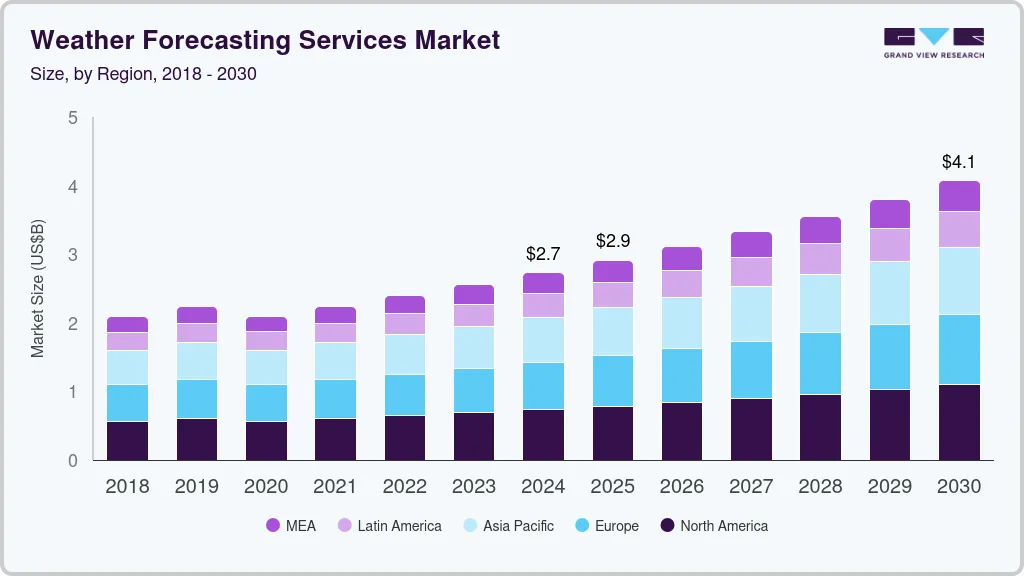The global weather forecasting services market was valued at USD 2.73 billion in 2024 and is projected to reach USD 4.07 billion by 2030, registering a CAGR of 6.9% from 2025 to 2030. This expansion is primarily attributed to increasing demand from industries such as agriculture, aviation, energy, and logistics, which rely on accurate weather information to ensure safety and operational efficiency.

Technological advancements in satellites, data analytics, and machine learning are enhancing the precision of forecasts and expanding their use across more sectors. Furthermore, the increasing frequency of extreme weather events—driven by climate change—is prompting both government agencies and private organizations to invest heavily in real-time forecasting capabilities. These developments, along with the growing incorporation of weather data into Internet of Things (IoT) platforms, are expected to significantly drive market growth over the coming years.
The growing demand for real-time weather updates is also fostering rapid innovation in the industry. Companies operating in transportation, agriculture, and energy are placing greater reliance on accurate, up-to-the-minute data to reduce operational risk. As a result, there is a surge in investments in high-resolution radar systems and IoT-enabled sensors, putting pressure on service providers to deliver faster, more dynamic, and location-specific forecasts.
Order a free sample PDF of the Weather Forecasting Services Market Intelligence Study, published by Grand View Research.
Key Market Trends & Insights
- Regional Overview: In 2024, North America held the largest share of the weather forecasting services market, accounting for 27% of total revenue. Increased climate instability and a rise in severe weather events have led both public and private sectors in the region to prioritize enhanced forecasting tools for disaster preparedness and risk reduction, especially across sectors like agriculture, insurance, and energy.
- By Organization Size: Large enterprises accounted for the leading market share in 2024. The growing need for seamless global operations and reliable supply chain management has led large organizations to demand highly accurate weather forecasting across diverse geographic regions. This helps in optimizing shipping routes, managing inventories, and ensuring uninterrupted field operations.
- By Forecast Type: The medium-range forecast segment dominated the market in 2024 with a 28.2% revenue share. Covering forecasts from 3 to 10 days, this segment is especially valuable to industries like agriculture, construction, and logistics, where short- to mid-term planning plays a vital role in resource allocation and productivity.
- By Industry: The media sector led the market in 2024 in terms of revenue. This growth is driven by the integration of weather analytics into advertising strategies. Media companies use weather data to enhance contextual advertising, aligning product promotions—such as apparel, beverages, and travel—with forecasted weather conditions to boost consumer engagement and sales.
Market Size & Forecast
- 2024 Market Size: 2.73 Billion
- 2030 Projected Market Size: 4.07 Billion
- CAGR (2025-2030): 6.9%
- North America: Largest market in 2024
- Asia Pacific: Fastest growing market
Key Companies & Market Share Insights
Leading market players are expanding their capabilities through technological innovation and strategic partnerships, offering services that go beyond basic weather updates to include risk management, climate adaptation, and predictive modeling.
- AccuWeather Inc.: A global leader in weather forecasting and analytics, AccuWeather offers hyper-local, highly accurate weather data. The company's services are tailored to support risk management in sectors such as agriculture, transportation, and energy. Its advanced forecasting algorithms and proprietary technology make it a trusted partner for both governments and businesses worldwide.
- The Weather Company LLC (IBM-owned): Utilizing AI and big data, The Weather Company delivers actionable weather insights for industries such as retail, insurance, and utilities. Its cloud-based forecasting platform, powered by IBM Watson, provides scalable solutions for weather-related risk mitigation and operational optimization.
Emerging players are leveraging technology to disrupt the traditional weather services model:
- Climavision: Specializing in hyper-local forecasting, Climavision operates a network of proprietary weather stations integrated with machine learning models. The company is rapidly growing its presence in energy, agriculture, and insurance sectors by offering precise weather risk data. Investments in edge computing further bolster its ability to provide real-time intelligence.
- Pelmorex Corp.: A Canadian-based weather services provider, Pelmorex is best known for operating The Weather Network. It delivers broadcast and digital weather forecasts supported by proprietary models. With an emphasis on AI and big data analytics, Pelmorex is expanding its enterprise services for sectors like agriculture, insurance, and retail by offering personalized alerts and weather risk solutions.
Key Players
- AccuWeather Inc.
- Vaisala Oyj (Weather)
- Climavision
- DTN LLC
- ENAV S.p.A
- Fugro
- The Weather Company LLC
- Met Office
- Precision Weather Services
- StormGeo (Alfa Laval AB)
- AEM
- Pelmorex Corp
Explore Horizon Databook – The world's most expansive market intelligence platform developed by Grand View Research.
Conclusion
The global weather forecasting services market is poised for sustained growth, driven by rising demand across weather-sensitive industries and rapid technological advancements. Real-time data needs, combined with the increasing frequency of extreme weather events, are compelling both businesses and governments to invest in more accurate and dynamic forecasting tools.
North America currently leads the market, but Asia Pacific is emerging as the fastest-growing region. As the effects of climate change intensify, demand for climate-informed forecasts and risk analytics will continue to grow—especially in industries such as agriculture, insurance, logistics, and energy. Major companies are responding by integrating AI, machine learning, and big data into their services, while newer players are innovating with hyper-local and real-time solutions.





